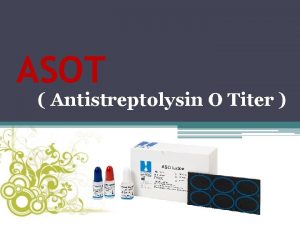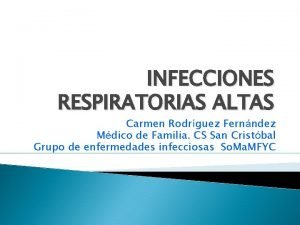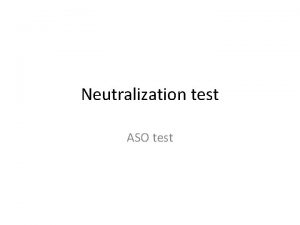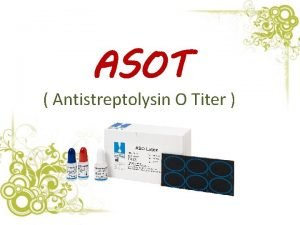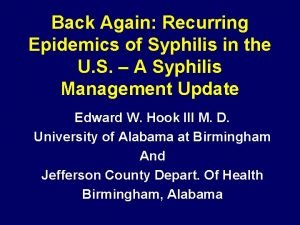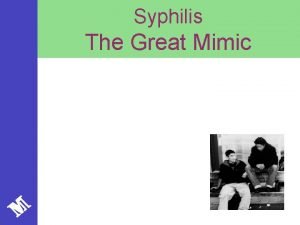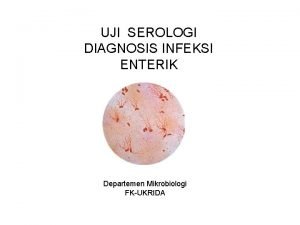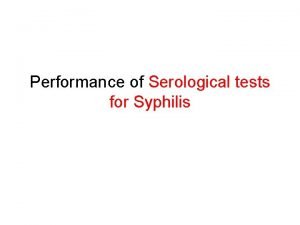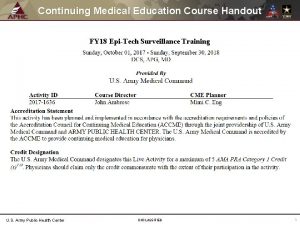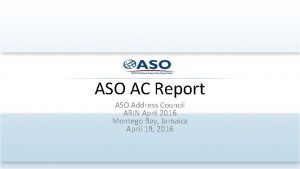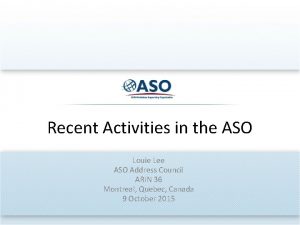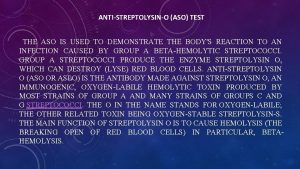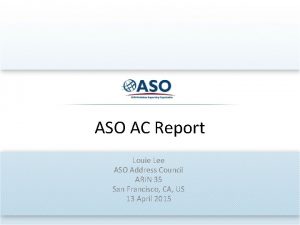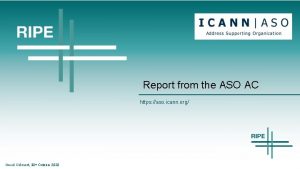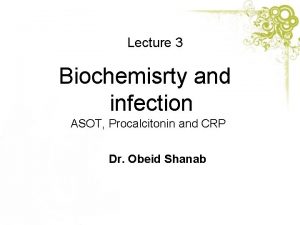ASOT Antistreptolysin O Titer FAlternative Names ASO ASLO












- Slides: 12

ASOT ( Antistreptolysin O Titer )

FAlternative Names : • ASO • ASLO • Anti-streptolysin O ( ASO or ASLO ) is an antibody produced against a toxin “foreign Ag” produced by Lancefield group A streptococci “ streptococcus pyogens”. • The toxin is called streptolysin O, the O stands for oxygenlabile; the other toxin that secreted is an oxygen-stable “ streptolysin S ”. • Both toxins are involved in producing hemolysis, in particular, Beta-hemolysis.

Significance of ASOT • ASOT testing is a procedure that demonstrate the presence of antibodies generated by the body against infections by group A streptococcus (S. pyogen) mostly for Tonsillitis and Rheumatic fever, this microbe produces the toxin streptolysin O, which cause destruction of RBCs cell walls. • This toxin is immunogenic, that is, the body produces antibodies against it.

▷ Note that : - • Antibodies ( Ig. G ) begin to appear in patient serum 7 -10 days after infection. • The antibody may be detected in the blood for weeks or months after the primary source of infection has eradicated. ▷ Incidence of detect a positive result during the : ◌ 3 rd weak of infection 90 -95 % ◌ 2 month ◌ 6 month ◌ 12 month 70 -75 % 35 % 20 % Incidence decreases as the time increseases ▷ If the titer doesn’t decrease with time ; this means that a recurrent or chronic infection may exist.

ASOT test • It is a latex agglutination test for the qualitative screening and semi-quantitative determination of antistreptolysin O antibodies in serum. • Specimen should be Serum collected in plain tubes. • Principle of the test : A stabilized buffered suspension of polystyrene latex particles have been coated with streptolysin O Ag when is mixed with a serum containing antibodies to streptolysin O , agglutination occur. • “ the reaction will occur within minutes “

Qualitative Test (Screening) 1. Bring all reagents and specimens to room temperature. 2. Place one drop (˜ 50 μL) of the positive control and negative control and 50 μL of the patient serum into separate circles on the glass slide. 3. Shake the ASO latex reagently and add one drop on each circle next to the sample to be tested and control. 4. Mix well using disposable stirrer spreading the mixture over the whole test area and tilt the slide gently. Agitate for about 2 minutes with rotator or by hand observe for the presence or abscence of agglutination.

Results Interpretation At Direct agglutination step : • No agglutination: ▫ serial dilution is done to exclude probability of prozone phenomena. ▫ The result is written less than 200 IU/ml. • Don’t write negative result. • Agglutination is observed: ▫ This mean that ASO Level of 200 IU/ml or more, and so Serial dilution is done to detect the exact titer.

Semi-Quantitative Test 1. Serum to be titrated is serially diluted (1: 2, 1: 4, 1: 8 etc) in 0. 9 g/L saline solution. 2. Place one drop of positive and negative control on slide. Do not attempt to dilute the ASO positive control serum for comparative or other purposes as no correlation exists between actual titre of the control and titre of unknown sera. 3. Place 50 μL of each serum dilution individually in successive circles on the slide and proceed as in screening methodology.

Results and Interpretation • The serum ASO titer can be defined as the highest dilution showing a positive result. The approximate ASO level (IU/ml) present in the sample can be obtained by the following formula: • ASO Titre (IU/ml) = Highest dilution with positive reaction x Reagent sensitivity ( 200 IU/ml) • e. g. if the agglutination is present up to a titre 1: 8 , the approximate serum ASO level is 8 x 200 = 1600 IU/ml”

Important notes about the test: • A positive test can indicate recent or current group A, C, and G streptococcal infection and may support the diagnosis of post-streptococcal infection complication • Elevated levels may indicate : 1. Active streptococcal infection. 2. Sore throat. 3. Rheumatic fever. 4. Scarlet fever. 5. Post-streptococcal glomerulonephritis. 6. Bacterial endocarditis.

Important notes about the test: • Increased titer can occur in healthy carrier • Repeating the test 10 days after the first test is recommended • Consider also performing another test like anti. DNase B (anti-deoxyribonuclease B), which, when combined with the ASO titer, can detect up to 95% of streptococcal infections compared to 80% with the ASO titer test alone • Antibiotics may give false-negative results by inhibiting streptococcal antibody response

Important notes about the test: False positive results(rise in titer)may occur in : 1. High fibrinogen 2. Gross hemolysis 3. High lipid in serum 4. Oxidized reagent 5. Bacterial contamination “ dirty slide “
